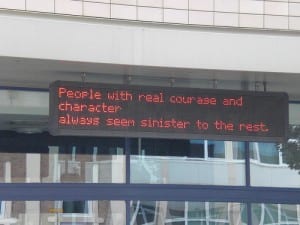Oh dear, I have been lax haven’t I? My last blog post was September 21st. Tut tut.
Anyway, as the University is closed for the day, and I’ve actually practiced what I preach for once and put today’s PGCE session on the VLE, and given the students some virtual discussion topics to get their teeth into, I find myself with a little free time again. Anyway, what’s got me going is a post from Joss about a paper by one N.Selwyn (2010). Now, don’t get me wrong here. I like the paper, and broadly agree with the sentiments expressed in it – the argument is essentially that research into educational technology is too often uncritical, focussing on idealised cases. Rather it should focus on studies of what is actually happening in the world of ed. tech., and explaining why things are as they are. No argument from me there.
Well, all right. Just a little one. I think there’s actually quite a lot of critical research into educational technology out there, and it has been quite helpful to me in preparing teaching sessions on technology. Just one example for now though, Masterman & Vogel’s chapter (Practices and processes for learning design) in Beetham & Sharpe (eds) (2007 “Rethinking Pedagogy for a Digital Age” discusses the influence of the academic department on individual’s choices about whether or not to adopt technology and goes on to show that there is quite a complex network of influences at work when academics design of digital learning activities. Admittedly it is largely theoretical, but that section of my session on technology in learning usually draws nods of recognition from PGCE colleagues.
Which leads me to my point. It is sometimes argues that technology changes working practices. (e.g. Cornford & Pollock, Putting the University online (2003). I sort of agree, but one of the things that I’ve always found quite interesting in my role in supporting the university’s VLE (We use Blackboard, but I don’t suppose any other VLE would be any different) is how much effort some colleagues (a minority, but enough to be interesting) will put into making it work in a particular way that suits their existing practice. Where this can’t be done, they’ll abandon the VLE, complaining that “the university” shouldn’t have bought something that doesn’t work. They may then either not use the tool at all, continuing with a pre-technological practice or, much more rarely, use a different tool, such as one of the web 2.0 tools. (Or occasionally using something within Blackboard that wasn’t designed for what they want to do, but sort of fits their purpose.) It wouldn’t be appropriate to give examples, here since to do so would identify individuals, and I am not suggesting that anyone is short changing students, or indeed that my impressions are anything other than subjective at this stage. Nor should this be read as making any assumptions of the sort that academics are inherently resistant to adopting technology, or insufficiently skilled to adopt it. (Although those might be dimensions that could be considered in a potential research project). Other dimensions would include; –
- Social pressures – if your head of department doesn’t show any interest, why should you?
- Student pressures – “My mate’s got his course on this thing – why haven’t you?
- Management pressure – We spent a lot of money on this. Why aren’t you using it?
I’m sure there are plenty of other dimensions. And, from a crudely Marxist perspective can we see this as the proletariat resisting Capitalist exploitation?
Hmm. Anyone got a research grant going spare?

You must be logged in to post a comment.